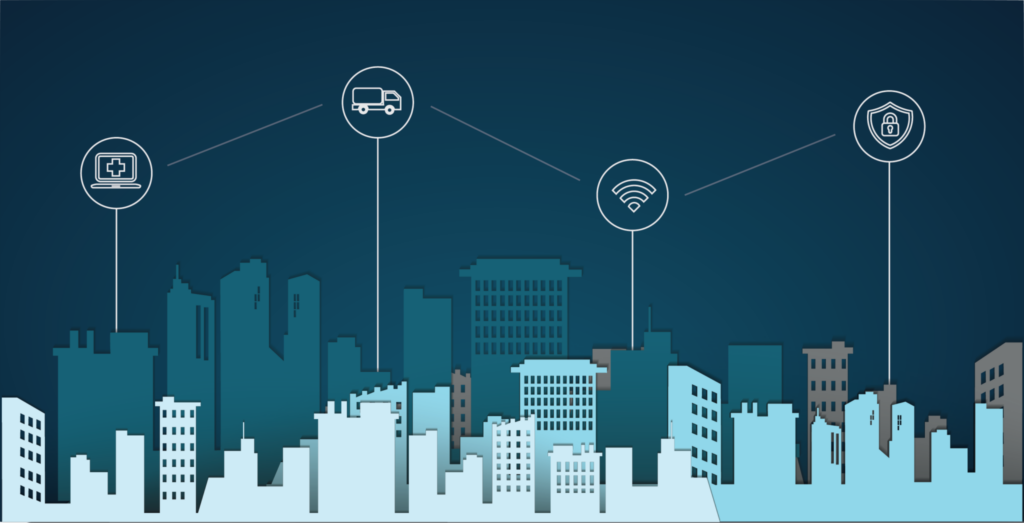
By Komal Doshi, Director of Mobility Programs
At Ann Arbor SPARK, we define mobility as, “Moving people, moving goods, and moving less.” It’s a definition that was introduced to me by my former employer, mentor, and friend Sue Zielinski. I am often questioned about the “moving less” aspect of mobility as it is often overlooked and not considered an essential part of the transportation discussion. The COVID-19 pandemic has brought the concept of moving less to the forefront.

Moving Less
It is easy to limit the scope of “moving less” to having access to home deliveries and adequate internet bandwidth and tools for video calls. However, it is considerably more complex. It is about developing systems that allow for reduced movement and heightened access for all individuals. The holistic view is essential to ensure that there is equitable access to services.
Examples of Moving Less
- Local Production and Distribution Systems: Develop systems that depend on physical proximity and decentralization. Additionally, engage modal diversity in distribution systems to achieve maximum efficiency and sustainability.
- Smart Growth and Mixed-Use Planning: When building and enhancing communities, focus on integrative thinking, which brings people and their needs closer through mixed-use (jobs-housing balance) and higher density (more compact) developments linked by transit and other sustainable transportation systems. It links decisions on issues such as transportation, infrastructure, land use, housing, public investment, and more.
- Remote Access to Work, Education, and Health: It is about creating dependable and engaging tele-educational systems, tele-health systems, and tele-work cultures that continue to serve and engage their communities meaningfully. It is about building the culture alongside the tools that can support more flexible learning and working styles for diverse backgrounds.
- Improved Utilization of Existing Assets: Creatively delivering services using existing assets, such as buses delivering food, vans becoming remote healthcare centers, etc.
As communities are grappling with what mobility means during this pandemic, it is highlighting the gaps within our mobility systems and creating opportunities for improvements. The focus on “moving less” has created an opportunity for a culture shift towards a more sustainable future where access is prioritized, and movement is only a means to an end.
Evolving Future Aspects of Mobility
All three aspects of mobility — moving people, moving goods, and moving less — are intricately linked and affect each other. Having an integrated and multimodal mobility system allows communities to be more agile and thus more resilient. This is an opportunity to evolve our systems so that they are more resilient and robust in tackling any future disasters, threats, and pandemics.
Examples of trends within Evolving Systems
- Digital Access and Cybersecurity: The pandemic has highlighted the need for expanding digital access to everyone as it is an essential element to ensuring equity. This is also an opportunity to ensure our cybersecurity infrastructure is developed alongside our expanding digital footprint. All communities must have information, tools, and services to support secure access.
- Increased Utilization of AI and Machine Learning: These tools are integral when predicting and planning for disasters, pandemics, and threats. Early prediction leads to executing responses quickly — the key to mitigating scope and impact.
- Rethinking the Supply Chain: The pandemic has highlighted issues within the supply chain. The path to recovery and then resiliency is still being developed but it will likely include increased digitization, increased sharing of data, improved privacy of data, increased collaboration (internal and external), and improved communication.
- Agile Multimodal and Seamless Transportation System: Within this segment lies the discussion around the impact of COVID-19 on various modes and what it could mean for our future.
- Public transit has been severely impacted by the pandemic. As we look towards the future, having contactless payments, integrated trip planning, and the ability to track vehicles can help public transit be more accessible while reducing interactions with drivers.
- While autonomous passenger vehicle services have been discontinued, autonomous delivery vehicles are being used in some places around the globe for contactless delivery. Scaling of autonomous bots fast enough is difficult and hence their role in the current pandemic is limited, but the potential growth and impact of this technology are undeniable. Autonomous technology can be very useful in ensuring the safe movement of people and goods during a pandemic and beyond.
- Shared services are key to efficient utilization of assets and though passenger services were discontinued in many cities, many have pivoted demand towards food, grocery, and pharmacy delivery. The hygiene and safety components that have come to the forefront of all these modes will be key for further development.
- Options like cycling and walking have increased in many cities and is a trend that cities must support both from an environmental and resiliency perspective.
- Evolving Work Culture and Leadership: This trend was already on the rise before the pandemic. The organizations that had embraced flexible work styles, focused on empathy, and encouraged bringing your whole self to work were able to cope better with the crisis in hand. Also, these were often the organizations that had adopted new communication mediums and tools to ensure people working remotely or at varying hours could be equally productive to their organizations.
As the world shifts from reaction to recovery and — finally — to resiliency, let’s consider how we can adopt some of our recent adaptations to mobility and access as enduring solutions. Most importantly, let’s be sure to look at communities comprehensively and focus on increased access for all so that we can build more connected, equitable, and robust cities.